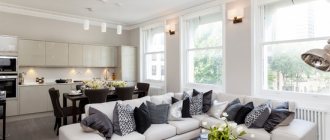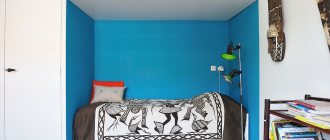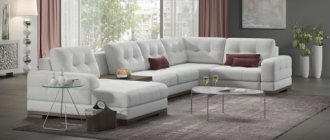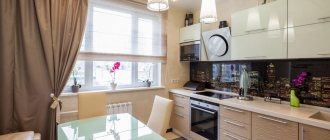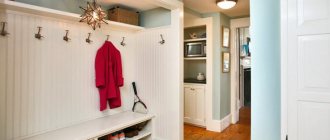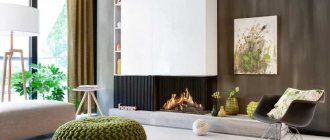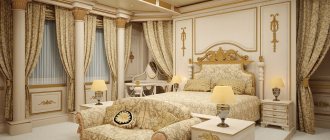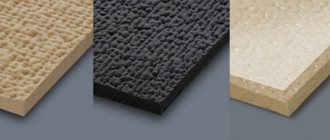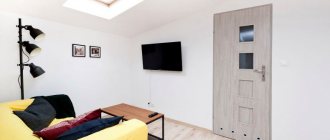The living room is undoubtedly the heart of the home. It reflects financial well-being and reflects the essence of the owner. It is also a place for receiving guests and gathering household members. Therefore, making high-quality renovations in the living room is an important decision. Where to begin? As usual, with:
- planning;
- budgeting;
- material purchases;
- hiring specialists or doing the work yourself.
How to renovate a hall
No matter how cozy the living room in the apartment is, sooner or later the understanding comes that it’s time to start renovating. Most people start renovations from the hall, and this is understandable because this is where the family meets guests, gathers for lunch, dinner and relaxes. For proper repairs, you need to draw up an action plan, be patient and buy high-quality building materials.
Before you start renovating the hall, you need to decide on the design of the room.
The instructions look like this:
The first step is to decide what the room will look like. Photos of interiors or the help of a professional designer will help with this. In the second case, you will have to spend money. The next stage is drawing up an estimate and purchasing building materials. You need to choose carefully, this will help you save financially. Next, the repair itself begins. We need to start from the ceiling. This is the most difficult area and if you don’t have confidence in your abilities, then it’s better to involve experts. Then you need to do the floor
It is important to remember that each type of flooring is laid in a special way and you should read the instructions before installation. The last step is finishing the walls
What kind of wall decoration will be depends on individual taste. At the final stage, you need to arrange the furniture, decorate the window, add accessories, flowers, and interesting little things.
A little patience, effort, financial investment and the new hall will be ready to receive guests.
Preparing the area for repairs and dismantling
Anyone who has been involved in renovating an apartment is familiar with the fact that preparing for renovation is an equally difficult stage.
READ ALSO: What glue is recommended to use for gluing non-woven wallpaper
Start your renovation work by preparing the rooms. If possible, empty the room of furniture; pieces of furniture that are impossible or have nowhere to take out, group them in the center of the room and cover with film. Placement exactly in the center of the room is necessary for access to the walls and ceiling from all sides of the room.
Peculiarities
Most often, living rooms are entrusted to professionals to renovate them in order to avoid negative effects and mistakes. But if you want to save money or not depend on anyone to realize your ideal, you will have to do the repairs yourself.
In an old panel house, the main problem that needs to be solved immediately is the lack of usable space. Capital work (including redevelopment) is quite expensive and almost always requires approvals. Therefore, they mainly carry out budget cosmetic repairs, limiting themselves to visual expanding effects.
As in any other room, the living room is renovated, starting from the ceiling. If there is an acute shortage of space, it is covered with plasterboard slabs. This solution, while elegant in appearance, saves a lot of precious time. The simpler the decor, external decorations and ornaments on all surfaces, the better the space of the hall in the “Khrushchev” will look.
Unlike the corridor, living rooms usually do not lack natural light. And if it does exist, then you should choose design options with two windows. Decide right away whether the openings will be located next to each other or on adjacent walls: sometimes a very interesting effect is obtained when they are placed on mutually opposite walls.
Space and lighting are extremely important. But what to do in an ordinary apartment, when no special delights can be organized, only a professional can tell you. It is then that seemingly insignificant accents acquire special significance. “Ordinary” apartments are renovated, first of all by finishing the surfaces - only then comes the turn of the arrangement as a whole.
Where to start?
From renovating a small secondary room, such as a bedroom. Additionally - with glazing, insulation and, possibly, combining the balcony with the room, without its final (finishing) finishing. The advantages of such a repair organization are as follows:
- The living room will require a large amount of high-quality materials, since it will need to be renovated for a long time. Having practiced on the same ones, but cheaper, you will be less likely to spoil the expensive ones later.
- Attaching a balcony will allow you to get additional living space, which can then be put to good use.
- It will also give you the skills to solve organizational issues regarding apartment redevelopment. In addition, the interdepartmental commissions under municipalities, which issue permission for redevelopment, have their own databases and, if a relatively simple redevelopment in the form of adding a balcony was previously carried out successfully, then it will be easier to obtain permission, say, to combine a kitchen with a living room.
- The balcony may be tiny, but only 1.5-2 square meters. m additional can make it possible to successfully solve the problem of repair as a whole, although in themselves they are neither suitable for the village nor for the city.
- Design skills are acquired. Whatever refined aesthetes may say, working with your hands not only gives you a sense of the material, but also develops artistic taste. Any technician knows: a durable and reliable design will certainly be aesthetically pleasing.
Planning the repair process
The design of a given room begins by identifying the functional areas of the room. The drawings indicate functional areas:
- area for receiving guests;
- sitting area in front of the TV;
- functional area intended for games, etc.
| Name of works | Unit change | Price (rub/m2) |
| Cosmetic | m2 | from 1,800 rub. |
| Capital | m2 | from 4,320 rub. |
| Elite | m2 | from 6,570 rub. |
| A surveyor’s visit, consultations, and drawing up an estimate are free. |
An example of an estimate for finishing rooms:
Estimate: living room, 15 sq.m.
Estimate: hall, 22 sq.m.
Estimate: bedroom, 12 sq.m.
Cost of finishing by floor
| Area (sq.m) | Dates | Price, rub) |
| 10 sq. m | 9 days | RUB 49,200 |
| 12 sq. m | 10 days | RUB 59,600 |
| 14 sq. m | 11 days | RUB 59,900 |
| 15 sq. m | 11 days | 74,500 rub. |
| 16 sq. m | 12 days | RUB 79,500 |
| 18 sq. m | 13 days | RUB 89,400 |
| 20 sq. m | 13 days | RUB 99,600 |
| 22 sq. m | 14 days | RUB 109,500 |
| 24 sq. m | 14 days | RUB 119,200 |
| 26 sq. m | 15 days | RUB 129,800 |
| A surveyor’s visit, consultations, and drawing up an estimate are free. |
Each activity requires a special organization of space. It is necessary to correctly set the lighting, choose the right finishing materials, optimally place furniture structures, and think about where it is most convenient to place switches and sockets.
Next, you need to choose a style solution for the living room, the main color scheme, and materials for cladding.
The final stage of planning is the selection of decorative elements, such as paintings, dishes, carpeting, curtains.
Floor finishing options
You will also not have any problems with finishing the floor. All existing materials are either glued or laid using elementary and often initially present means of fixation, or they are poured in accordance with special technology.
Laminate
Laminate
An excellent material for finishing floors. Laminate flooring combines high performance and relatively affordable cost. It is extremely easy to install - just lay out the panels correctly on a previously prepared surface. Fasteners are present initially. Requires preliminary installation of a special substrate.
Parquet
Parquet
Completely natural material with the highest environmental friendliness. Expensive coverage. Requires special care and careful handling.
Cork covering
Cork covering
Environmentally friendly material with good noise and heat insulation characteristics. The coating is pleasant to the touch, resistant to various external influences, but does not tolerate aggressive cleaning.
Linoleum
Linoleum
The most popular type of floor covering. Linoleum is extremely easy to install. The main thing is that the base is as level as possible. The material is undemanding and easy to maintain, and tolerates external influences well.
A large selection of colors and textures is available on the market, which allows you to choose linoleum that fits perfectly into the interior. Sold at an affordable price. To increase service life, a special underlay should be laid on the floor before installing the coating.
Self-leveling floors
Self-leveling floors
Modern covering. If done correctly, the result is a perfectly flat, seamless surface. Floors with a three-dimensional effect deserve special attention.
They have a long service life. They are quite labor-intensive to install on your own and require strict adherence to technology.
Carpet
Carpet
A good option for finishing flooring. Eliminates the need for additional thermal insulation measures. The coating is beautiful and pleasant to the touch, but very demanding to care for and handle.
Choosing a style based on layout
The most popular types of living rooms are found in old layouts, and are classified by type: compartment, box, corridor and narrow-shaped room with a sleeve, the so-called “hole with a hole”.
In brick houses “Khrushchev” or “Brezhnevka”, you can often encounter a small box in which finishing will be quick and cheap, but there is a problem with furniture. These layouts allocate no more than 5 square meters to the living room - not enough to provide high functionality and spaciousness.
In panel houses there is often a long room where it is difficult to add variety due to the small square footage, and the main task is the correct placement of lighting. Similar to this principle is a hole with a hole where, apart from paintings, no interior elements simply fit.
A living room compartment is simply an ideal option, which is typical for both Stalinist and new buildings. It consists of a square or rectangular hall, which turns into an adjacent narrow corridor.
This variation may include steps, niches and other architectural features. Here you can already turn around: there is enough space, all surfaces are spacious. It is important to rationally use this space and focus on high-quality designer finishing materials.
Beautiful DIY living room renovation
The beautiful interior of the hall should suit everyone who finds itself in it. There are a lot of tastes and preferences of thousands of thousands, but you can make such an original and unusual accent that even the most excellent and experienced designer will look at the room without stopping.
There are several recommendations for updating your living room:
- For rooms with high ceilings, you can use optical illusion techniques, for example, by pasting wallpaper with horizontal stripes or by laying borders, moldings and modular paintings.
- You can visually enlarge a room by installing large window frames and doorways, as well as three-dimensional paintings.
- If you want to create the effect of heaviness and massiveness of the ceiling, then you can use a canvas for the walls that has a checkered pattern.
- Diamond wallpaper can expand a room, making it great for small spaces.
- If you have awkward-looking window frames or their irregular shape, small size, or elongated shape, the most important thing is to choose the right curtains.
- Drapery can be used to expand windows.
- To narrow the window frame, you can hang curtains to the height of the wall, but according to the size of the window opening.
Choosing a floor covering
The floor is the surface that bears the heaviest load, including heavy furniture and, of course, constant walking. The choice of material depends on whether you plan to receive many guests, or whether you want to turn the living room into a cozy island for privacy and relaxation. To finish the floor in the hall use the following:
- Laminate is a beautiful, high-quality and fairly inexpensive finishing material. The surface of this material can imitate natural wood of any species. There are panels painted in more exotic colors;
- Parquet is a natural and environmentally friendly material made from various types of wood. Using parquet boards laid out in one pattern or another, you can decorate any room. Parquet is quite expensive, so it is used very rarely in ordinary apartments;
- Cork floors are an excellent natural material based on the bark of the cork oak tree. This floor has good noise and heat insulation qualities. The material is hypoallergenic and not hazardous to health. Cork can be used as a stand-alone covering or as a backing for laminate flooring;
- Linoleum is one of the most popular materials used in living room renovations. Why? It is very easy to install; even a beginner can handle this floor. The surface of linoleum can imitate natural materials from wood to granite and marble;
- Self-leveling flooring is expensive, but it is perfectly smooth and a very beautiful option. The coating with a 3D pattern looks most impressive;
- Ceramic tiles are not the most suitable option for the living room. It is better to leave it for the kitchen area if the room is combined.
When thinking about renovating your living room with your own hands, choose natural wood, cork or laminate for the floor. If desired, you can also install a heated floor system.
By correctly arranging the texture of materials and their colors, you will create a harmonious and beautiful interior in the room. Renovating a living room with your own hands is not that difficult, the most important thing is to decide on it.
Source
Original interior elements for the “ideal” living room decoration
Before we move on to specific interesting ideas for arranging your living room, let's look at the original interior elements that can decorate and make the decoration of the room for receiving guests more functional. After all, it is some of these elements that you will use when decorating the original interior.
- “Glowing” stretch or combined ceiling. This is one of the most original design options for the ceiling surface, which in some cases turns your ceiling into a work of art. Such a ceiling will not only decorate your room for receiving guests, but will also act as a backlight, filling the room with a romantic spirit. “Glowing” ceilings are stylized in different ways: “night sky”, “sunny sky”, “summer forest” and so on. You can read more about this on special websites about stretch ceilings.
- Original multi-level ceiling structures. With the help of multi-level ceilings, you can solve several design problems at once: decorate a room, divide it into functional zones, visually expand the space of the room. Multi-level ceilings are not cheap, but they are worth it.
- Fireplace or its imitation. Since ancient times, the fireplace has occupied a place of honor in the home in many interiors of different countries. We associate this element of the interior with warmth, coziness, comfort and at the same time with something homely, painfully familiar. Of course, installing a classic fireplace in the living room of a Khrushchev apartment would be very problematic, but the market offers options that look no worse - electric and false fireplaces.
- Originally designed custom-made designer furniture. When ordering cabinet and upholstered furniture, you can completely give free rein to your imagination, and the designer of the manufacturing company will tell you how best to realize your ideas. Today the market offers you a huge variety of materials and technical solutions with which you can implement your plans relatively easily. We urge you not to get hung up on classic furniture or those options that are offered by retail outlets - “invent” furniture for yourself.
- Modular paintings for wall decoration. Modular paintings are another trendy design element of a modern living room. The essence of the original idea is to place on the walls a painting consisting of three or more disparate canvases, which together form a complete image. To emphasize the segmentation of the image, designers place the canvases not close to each other, but with some spacing.
This is not a complete list of original interior elements that are worth paying attention to. We have just provided a few examples in the hope that by doing so we will be able to motivate you to independently search for ideas for your future magnificent living room
Reflect your life in your living room interior
Very often, the most original ideas for decorating a living room are already present around you; the main thing is to be able to grab hold of them and implement them correctly. Often a profession or hobby helps to “give birth” and implement ideas for exquisite interior design of a room for receiving guests. Some people create accessories, making beautiful things from wire and beads.
Someone, being a professional photographer, will decorate their living room with an exhibition of photographs. We could predict in advance that this might not be possible, but we hope we were able to convey the general idea. It is not necessarily your job or hobby that will determine the overall interior concept of the living room; perhaps you will allocate a separate area in it, which you will decorate in accordance with the spirit of your hobby.
If the design concept allows, then you can fill the interior of your living room with objects that are in one way or another connected with the history of your family. At first glance, this idea seems old-fashioned, however, in modern design it has been revived and is being actively used again. Of course, this does not mean that you need to drag your grandmother’s old shabby wardrobe into your living room or your grandfather’s armchair, wrinkled from time to time, which you took from the attic; everything should be reasonable and correctly combined with the interior composition of the room.
And finally - design!
Renovating the living room “just somehow” is nonsense. A living room without style is not a living room. It is quite possible to decorate your living room stylishly on your own; in extreme cases, a well-executed sketch will allow you to avoid the expensive services of a designer. Let us introduce the reader to some hall design styles that do not require extremely high qualifications to develop.
Interior design styles are divided into groups - clones. We will not consider the classic clone (empire, rococo, etc.): the styles of this group require spacious, high rooms and will not give the effect in a modern apartment. Modern interior design comes primarily from Art Nouveau.
Modern styles
Classic modern
Art Nouveau as a direction in the decorative arts arose from the desire to get rid of the “trinkets” that had accumulated over centuries, under the slogan: “Everything ingenious is simple!” Simple shapes, smooth surfaces, precisely maintained colors (see figure below), and simple designs turned out to be successful not only in aesthetic terms: Art Nouveau made it possible to simplify and reduce the cost of construction technologies and improve sanitation and hygiene of premises. As a result, Art Nouveau has become, and remains, the dominant style in interior design. Modern construction technologies are focused primarily on modern design solutions.
Modern living rooms
Minimalism
They began to “modernize” popular Art Nouveau in whatever way they could and in whatever way they could, so that soon “Modernist” works appeared that no one could distinguish from Baroque or a Polynesian hut. This gave rise to the reciprocal delights of the modernist orthodoxies (antinomy, but in art something else doesn’t happen...) - minimalism, see fig. The origins of minimalism, among others, are traditional Japanese interiors, so in a mini living room, curtains, panels with a complex pattern, and, especially, indoor plants are appropriate in a limited area. “Mini” connoisseurs argue that a mini is not a mini without bonsai, but caring for them is extremely difficult, so ordinary minimalists make do with non-mini vegetation.
Living rooms in minimalist style
High tech
Not everyone likes too minimal minimalism, and life changes. Its current intensity and functionality are expressed in high-tech style. Its distinctive features are right angles, extensive plain planes, shiny polished metal, glass, glazed ceramics, see fig. Wide rectangular openings with sliding doors or screens fit harmoniously into a high-tech living room, which can be important for combining rooms without redevelopment.
High-tech living rooms
Art Deco
The desire to bring the seemingly simple, but extremely subtle styles of “high modern” closer to the mass consumer gave birth to art deco (the correct pronunciation in Russian transcription is art deco); translated as decorative art. The main expressive role in it passed from form and surface to decoration, see fig. The “signature” features of Art Deco are considered to be the combination of polished golden metal with ceramics and a ledge ceiling.
Art Deco living rooms
Art Deco is also called “jazz modern” - it appeared after the First World War, at the height of the jazz craze. A jazzman does not have to have a conservatory education, but he certainly must feel swing and be able to swing, otherwise he can play anywhere, but not in jazz. Likewise, Art Deco can be well executed by an amateur who has an innate artistic taste and sense of proportion. In this case, a floor lamp in the form of a full-length naked female figure, an African mask, and a bust of Berlioz will fit into the Art Deco living room. Not Bulgakovsky, Hector Berlioz, the great French composer.
Fusion
Another side branch of modernity in the direction of maximum self-expression was fusion. Its signs are a combination of incompatible things: pretentious forms with general laconicism, flashy color tones. Aesthetic and meaningful fusion is possible (see figure), but it requires impeccable taste and mastery of the finest working techniques, otherwise it will turn out to be a tacky gag.
Fusion living rooms
Ethnic clone
Ethnic interior styles come from traditional folk ones. Good designers try to preserve them in their original form, and there are as many styles as there are nations. Therefore, we will touch upon only two popular, and at the same time, developed to their own, separated from their origins, concepts.
Country
Country means rustic, rural, country. Not only men lived in nature, but also in the bar, so Russian country music is not necessarily something cut-to-length, see fig. Its visible signs are massive wooden furniture of smooth shapes, draperies, bedspreads, pillows, furniture runners with embroidery, natural (or exactly like natural) finishing materials.
Country living rooms
In “peasant” country, logs are now being replaced with a blockhouse, but “gentleman” remains the most expensive: country is not country without a real fireplace and a wide French window overlooking the garden or with a view of nature. Luxury is not one of the indispensable attributes of country: if you have taste, you can decorate an unpretentious but sophisticated country living room in a country house or in a country estate.
Feng Shui
Feng Shui is also originally an ethnic style; in Chinese - water and wind, i.e. - the same country, only eastern. Without going into its esoteric aspects, we will only point out that Feng Shui is determined primarily by the orientation of the room to the cardinal points and the arrangement of furniture in it. Therefore, decorating a Feng Shui living room in a traditional Chinese style, as in the picture in the center, is not at all necessary. A European-quality renovation of a living room in the Feng Shui style is quite possible (left and right in the figure) without violating the dogmas of the doctrine.
Feng Shui living rooms
Candy + modern?
The bourgeoisie, burghers and gentry always wanted to live like nobility, but they could not pay for the work of the best craftsmen of their time, and they were stingy. The unsystematic borrowing of “beauties” from classical styles gave rise to the “haberdashery” style, in Fig. on the left, along which we drove from Voltaire to Mayakovsky and beyond.
This pink, fluffy and cute little motley is nothing short of glamorous, so to speak, classic. Playful in appearance, it is in fact highly functional: as you know, this is how the work spaces of ladies employed, in the language of their employers and operators, are very often decorated in the service sector.
Glamorous living rooms
However, consumers of this kind of designer products are not decreasing, and demand creates supply, so glamor is alive. Moreover, the tolerance and capacity of Art Nouveau turned out to be so great that, without even wincing, he accepted glamor without spoiling his health in the least: modern designers, using Art Nouveau techniques, create elegant and expressive glamorous living rooms, see fig. on right.
Examples of space zoning
Often the hall in an apartment is not only a room for receiving guests, but also a living room, especially in one-room apartments or studios. In this case, it becomes necessary to zoning the room.
The room is divided into functional areas using columns and a sofa
Functional zones can be separated from each other using visual and material methods. The visual tools are the separation of color, material, decor, lighting or accessories, and the material tools are furniture, partitions, screens, podiums, arches and other zoning options.
Furniture
In a combined kitchen-living room, dining or upholstered furniture can serve as the main elements of interior zoning. In the first case, a dining table and chairs are installed between the living room and kitchen space, and in the second, a sofa is placed with the back to the kitchen, separating the relaxation area from the working area.
Massive upholstered furniture is perfect as a space divider
In a separate living room, you can use furniture to similarly create different zones by grouping appropriate furniture and accessories. For example, a sofa, armchairs and a coffee table make up the reception area, and a bookcase, floor lamp, and armchair make up the reading area.
Partitions
In the modern layout of the hall, partitions and screens play an important role. Stylish glass, plastic and wooden partitions can create a unique atmosphere in a room and divide the space into functional zones.
Using a light partition you can separate the sleeping area from the living area
In small apartments, you can use a partition to separate a sleeping or working space from a relaxation area, and in large rooms, use screens to create coziness.
Other options
Podium, steps, arches, bar counters - all these options are used in the design of modern interiors. The podium will help create a sleeping area in a one-room apartment, steps, an arch and a bar counter will separate the kitchen from the living room in a combined layout.
The podium allows you to divide the room into zones, while creating a stylish interior
For a large living room, visual zoning methods are suitable, for example, color schemes, accessories and decor.
There is no need to use several room zoning options in one room, otherwise the design will look overloaded.
PPR (sequence of work)
Any construction work begins with a documentary cycle and continues with the production (worker) cycle. The sequence of work in the living room exactly coincides with, say, the stages of renovating a bedroom or other living room.
A living room renovation is carried out in the same way as any other room renovation, but you need to keep technology in mind at the design stage. For example, primary (starting) plaster with isogypsum with a cover (front, finishing) satengypsum will allow you to get a perfectly smooth surface for any painting, including acrylic enamel that gives a “mirror” or especially soft and thin grisaille on thick plaster. But the heavy cladding of decorative stone tiles on it will eventually begin to fall off with layers of plaster; here you need cement-based starting plaster.
The second point is that people don’t walk around undressed in the living room, and everything is visible to the guests. Conclusion - during the repair process it makes sense to install heating radiator screens. Finally, highlighting the dining area with a porcelain stoneware floor covering is justified from all points of view, but a stepped floor screed is needed underneath it.
Documentation of redevelopment, if necessary, and obtaining permission for it are also carried out in the usual manner. Designing the furnishings of a hall is even simpler than designing kitchen equipment: it is quite possible to get by with flat cardboard applications on a sheet of paper.
But the first stages of design - zoning the room, choosing the type of finishing and finishing materials, design development - require a careful approach. As a result, you need to get, if not an exact plan according to SNiP, then at least sketches with dimensions for yourself - working by eye is doomed to failure.
Walls
Before you begin decorative finishing work, you need to prepare the walls well. First they are leveled with starting putty, then with finishing putty. If the walls are severely deformed, it is better to use drywall. With its help, you can create niches, columns and other geometric structures to the delight of designers. Drywall is attached to a metal frame, then covered with finishing putty and decorative finishing.
The prepared walls are covered with wallpaper; it is inexpensive and cozy. Using their image, you can “play” with space: a horizontal pattern expands it, a vertical one stretches it out.
The walls are painted with water-based, acrylic or water-dispersed paints. This is the most budget option for finishing work. It is not necessary to paint all surfaces the same color; you can play with an accent or contrast of shades.
Decorative plaster is in great demand. It hides wall unevenness and has no color restrictions. For families with small children, there is a good opportunity to preserve the walls - decorate them with panels up to the level of reach of children's hands. This material can be made of wood, plastic, cork, MDF, as well as laminate and glass.
In private houses, one of the walls of the hall can be cleared to the ground. Brickwork will be an excellent support for the loft style. The original finishing solution is natural or artificial stone.
Ceiling decoration
Please note: if you decide to install suspended ceilings or suspended ceilings in the living room, then do this when the finishing of other surfaces is completed.
So, depending on what interior design you have chosen for your living room, a variety of materials are used when decorating the ceilings. Most popular:
- The design of suspended ceilings is divided into two main types: modular (divided into lattice, cassette and slatted) and solid in the form of a stretch ceiling or plasterboard structure;
- Expanded polystyrene boards are easy to install and quite cheap. What does this ceiling look like? Quite nice, but don't expect sophistication from it;
- Paint can also be considered an inexpensive surface design option. Unlike wallpaper, this material is resistant to moisture, so the ceiling can be washed during cleaning;
- Wallpaper is the simplest and most economical option. Given the abundance of textures and colors, you can easily choose a coating that will harmoniously fit into the interior.
Important: some types of suspended ceilings are difficult to install, so you will have to seek the help of professionals at this stage.
The best option for decorating the ceiling in the living room in terms of price and quality is plasterboard and proper lighting. This is not surprising; such a ceiling is practical and beautiful. A stretch ceiling will cost more, but it also looks beautiful and stylish.
Such significant little things
A variety of decorative elements will help give a beautiful and finished look to the renovation of the hall. Accessories should be in harmony with the overall design style. Even the most minimalist design needs bold touches and eye-catching details to add interest to your living room. Various textile products will create a unique atmosphere. Fabric lampshades, embroidered pillowcases, curtains with garters or a bright carpet will complement and highlight the unique decoration of the room.
Harmonious combination of curtains with other elements of the interior of the room
The walls can be decorated with collages, posters, paintings or an impeccable selection of photographs. The owners are happy to use photo wallpapers with picturesque landscapes and world architectural monuments for interior design. Depending on the style, you can place a map of the world or the starry sky, animal skins and even hunting rifles on the walls.
The walls above the corner sofa are ideal for displaying family photos
Additional thematic items will serve as an original decoration for the living room. They will tell you about the tastes and hobbies of the owners. A giant globe, a wine barrel, stuffed animals, whimsical sculptures or artistic compositions will help enliven the interior.
Non-standard items help diversify the interior, for example, like this coffee table with a bar in the shape of a globe
Another design attribute is lighting fixtures. A massive chandelier with a scattering of beads and many lamps can become the main element of the decor. The product market offers lamps for every taste and color, from large floor lamps and spotlights to elegant sconces and shades.
Lamps in the hall, in addition to their main purpose, can also play an important decorative role
Proper lighting will create additional comfort and emphasize the dignity of the living room.
The key to success in choosing accessories is moderation. An excessive amount of things only clutters the room. A hall with the most wonderful European-quality renovation will lose its attractiveness due to the abundance of details.
To radically change the atmosphere in the room, sometimes one item with an original design is enough
First stage
Before preparing the living room for renovation with your own hands, several important issues need to be resolved. This stage requires the approval of all family members, if you live alone - a lot of thought and drawing up a room plan.
Before starting repairs, decide the following:
- where to put the TV and multimedia devices;
- where to place the sofa and armchairs so that you can clearly see the image on the screen from any place;
- will a table with a personal computer fit in the room, or will it be necessary to replace it with a compact laptop;
- where to store books, photo albums, sets of dishes, clothes, linen, etc.;
- where to place chandeliers, lamps and floor lamps, is it necessary to highlight a specific area of the living room with light;
- Is air conditioning needed in the room?
- the presence of additional decorative elements on the walls - photographs, paintings, frescoes, mirrors;
- Is LED lighting on the ceiling necessary?
- Do you want to arrange a corner with a fireplace;
- The most important thing is: are you able to think through the interior of the room from start to finish, or do you need to turn to the services of a professional designer?
Comfortable layout of a small living room
These questions seem trivial, but the further choice of materials, the plan for upcoming renovation work and the total cost of renovating the hall depend on them.
Colors and prints
The color options for the living room can be very different, but a prerequisite for their use is a clear choice: which elements will become the main ones and which will be background inclusions. It is not advisable to make accent zones that are too large or create them in significant quantities. It is recommended to decorate the ceilings in light colors; this will help increase the apparent volume of the room.
- Gray tones are unreasonably considered to look dull and create boredom, but in fact, if the combination is chosen correctly, it fits perfectly into any color combinations.
- Green painting is recommended if the windows are facing north, otherwise lilac shades should be used.
- When a red tone is actively used in the design of a room, furniture in other colors will help to dilute its excessive saturation.
Don’t rush to immediately apply the most fashionable color of the current season; after that, you often regret the ill-conceived decision. See what fits into the environment and what doesn't.
Wall decoration in the living room
A classic type of wall decoration is wallpapering. Everything here follows the same principle: dismantling and removing garbage, finishing the walls with primer, as well as plaster and putty. Only after completing these points can you begin to grout the walls and use the finishing decoration.
Vinyl wallpapers are considered the least susceptible to fungus. Their surface is easy to clean, they serve for a long time and do not lose their original shine. The best option for the living room is also considered to be cork, which is applied in a thin layer to paper and pasted in a similar way to wallpaper.
To prevent the cork from looking monotonous and boring, it is combined with rich wallpaper inserts or panels, paintings and photo wallpapers. Such a surface is easy to maintain, completely environmentally friendly and safe for residents. Cork is not used in dark and narrow living rooms, because this material absorbs a lot of light.
Plastic wall panels or laminated chipboards are an aesthetic and cheap option, characterized by ease of installation and subsequent operation. The disadvantage of such a finish is considered to be the size, which can “take away” up to a couple of centimeters of space on each side.
An excellent alternative to panels can be decorative plaster or liquid wallpaper, which may contain silk, cotton, linen or paper fibers.
Decorating and protecting walls with liquid wallpaper with your own hands is also easy. It is enough to fill the dry mixture with water and after the flakes are completely absorbed, apply with a spatula. The thickness of the finished layer cannot be more than 2 mm.
Decorative plaster is a widespread and favorite variation among many designers, which offers a wide variety of decorations and lasts for a long time. With the help of a layer that has not yet frozen and imagination, you can build an original panel or a whole picture from it. In order for the real material to wash well, it is opened with a special varnish.
About finishing methods
Ceiling
The ceiling in the living room can be finished in the following ways:
- Painting is a traditional, cheap and far from the worst way. Any methods of organizing space themselves “eat away” the light in the room, and a uniformly white ceiling “catches” well and reflects everywhere the slightest reflections from the windows. Painting with acrylic enamel on solid drywall enhances the effect and, in addition, does not create dust or peel.
- Wallpaper - liquid decorative wallpaper is suitable for the ceiling. A light, cheerful ceiling will immediately expand the visible space of the room.
- Foam tiles are short-lived, but cheap and easy to replace. If not exposed to direct sunlight, it may last for 5-7 years. Suitable as an excellent light-reflecting material for ceiling cladding above the work area.
- A false ceiling is quite expensive and difficult to work with, but can be equipped with LED lighting and actively participate in space zoning and design techniques.
False ceilings, in turn, come in the following types:
- Overhead - sheathing on the sheathing with virtually no inter-ceiling space. They almost do not take away the height of the room, but only electricity can be laid from communications under the cladding.
- Tension - a panel made of fabric or film. They are remarkable in decorative and aesthetic terms, but in all other respects they are bad: they do not last long, they do not hold any communications, they burn out and become stained when heated by lamps.
- Suspended - assembled or mounted on a frame suspended at a fairly considerable distance from the base ceiling. They are quite expensive and difficult to work with, but with sufficient height the premises allow you to solve all the problems of the ceiling, functional and decorative, and, in addition, provide space for laying any communications.
Suspended ceilings are also divided into several types according to the nature of their implementation:
- Cassette ceilings are Armstrong type ceilings. Decorative fiber boards, raster lamps, and ventilation grilles are placed in the cells of a light, simple frame. Everyone is nice, but they turn the apartment into an office.
- Frame - the sheathing is attached from below to a durable metal frame made of perimeter profiles, load-bearing U-profiles and connecting C-profiles. They can be solid and modular - in the form of a frieze, cornice, ceiling, which do not occupy the entire area of the base ceiling.
- Stepped (multi-level) - complex frame ceiling. The frame is reinforced, “multi-story”. It can be modular, leaving free sections of the base ceiling, or combined with tension or cassette inserts. The pinnacle of ceiling craftsmanship and wide scope for the designer, but complicated and expensive.
Suspended ceilings are usually sheathed with plasterboard, which allows it to be formed into curved surfaces. Less commonly, laminate, plastic lining, lumber, and plywood are used for ceiling cladding. Ceiling cladding with dense slab materials is an exception: securing heavy tiles securely while suspended is difficult and requires high skill.
Walls
Walls, as you know, are plastered, painted, covered with wallpaper or sheathed with laminate, plastic panels or slabs, wood, plasterboard over wooden sheathing or ceiling metal profiles, but lying directly on the wall. Sometimes they are partially or completely covered with ceramic tiles or decorative stone.
The best option for the living room is cladding or cladding a third or half the height at the bottom, and wallpaper up to the top.
This will save expensive materials, properly distribute light with light wallpaper and protect the walls below. But sheathing on the sheathing throughout the entire height of the structure will provide effective sound and heat insulation. In block Khrushchev buildings this is especially important, and plaster and wallpaper on walls made of old reinforced concrete do not hold up well, so solid cladding is better here.
Floor
The plank floor along the joists is becoming obsolete. Modern construction technologies make it possible to form a screed so smooth that it can be used to lay a finished floor over a plywood pad, or even directly onto the base surface.
Decorative flooring in living rooms is most often the following:
- Parquet is a traditional material that never loses its position. Modern parquet mastics and installation adhesives allow you to lay it either directly on the screed or on a plywood pad.
- Laminate is the most popular flooring material. Having a completely “plank” appearance, it is durable, resistant to wear, and easy to work with when done independently.
- Linoleum is not at all a budget ersatz of parquet and wood. Modern types of linoleum have exceptional advantages (see below) at a relatively low cost.
- Ceramic tiles - porcelain tiles are great for the dining area. Not cold in appearance or to the touch, non-slippery, durable, very easy to clean, chemically resistant, available in a wide range of tones and textures. But to combine it with other types of floor coverings, a complex, labor-intensive and costly step screed is required.
- Cork flooring is recommended for children's rooms: it is hygienic, environmentally friendly, and warm and resilient. Suitable for the living room if it fits into the design. Can be made floating on the base surface, i.e. easy to work independently.
- Decorative self-leveling flooring is warm, elastic, durable, can be poured over old rough and bumpy screed, and is also available with a 3D pattern, but is very expensive.
- Adjustable floor - allows you to level the base surface to within a fraction of a millimeter, but is expensive and takes up a lot of room height. It is installed, as a rule, in luxury housing under decorative flooring made of wooden inlay, etc.
Original finishes
And at the end of the section on finishing, let's mention some modern wonderful materials.
Cork wallpaper
Cork wallpaper is a layer of pressed cork chips on a paper or fabric base. Weakly susceptible to dirt, easy to clean, and provide “breathable” walls. They reflect light poorly, so they are not recommended for a nursery or bedroom, but they are quite suitable for a relaxation area in a bright living room. They are produced tinted, in the form of sheets with ready-made decorative panels (see figure); gluing is possible with a turn around the corner. Cork wallpaper swells when liquid is spilled on it, but it does not absorb fumes and does not retain odors, so it is also suitable for a kitchen combined with a living room.
Cork wallpaper
Liquid wallpaper
Liquid wallpaper is gypsum plaster of a special composition with the addition of organic flakes and fibers. Prepare immediately before application according to instructions. The advantage is individuality with simple standard technology: the resulting drawings are unique.
Decorative plaster
Venetian decorative plaster - mineral chips or stone flour of different shades are added to gypsum plaster. For centuries, the most skilled painters have worked on Venetian plaster, but now it is confidently entering the mass construction market: manufacturers offer ready-made dry mixtures that allow them to imitate marble, crinkled fabric, frosty patterns, snakeskin, etc. With practice, you can prepare Venetian plaster yourself and, without any artistic education, use it to paint slanting streams of rain, tree branches or simple patterns, multi-colored stripes on the walls.
There is also another similar method of decorating walls - textured plaster. Read more about it at the link.
Marmoleum
Marmoleum is a modern type of linoleum. Eco-friendly, made from natural materials. Durable, not afraid of even a thrown cigarette, long-lasting durability. Does not require preparation of the base surface for the flooring; floating flooring possible. Provides heat and sound insulation, has bactericidal properties. It is not afraid of household pollution and grains of sand from shoes, like laminate and parquet. Lasts for decades in public buildings. Available in rolls and slabs, the choice of textures and shades is constantly expanding. The only drawback is consumer prejudice against linoleum.
Bamboo parquet
Bamboo parquet has advantages comparable to marmoleum. Unfortunately, the finished coating has a somewhat wavy surface, which can be felt even through slippers with felt soles.
Living room-bedroom
The bedroom and living room in the same room are most often divided in the following ways:
- Introduction into the interior.
- Separate sleeping area.
- Dividing attention.
Let's look at the examples shown in the figures.
On the left is a men's or family bedroom-living room. The simple shaped bed is covered with a thick blanket in a neutral tone. To completely cover its purpose, you also need to introduce the bed into the interior. This is achieved with the help of connecting elements, in this case – pillows. Their colors on the bed and sofa are similar, and 2 out of 3 on the sofa have pillowcases made of the same fabric as the bedspread. As a result, the bed is no longer a bed, but an ottoman, which does not evoke inappropriate associations in anyone. Curtains that enclose the sleeping area do not play a special role in the decor here and can be anything.
Living rooms-bedrooms
In the middle is a combined one-room apartment for a business lady or a playboy gentleman. The zones are separated by a thin decorative partition. With a solid overall design, the functional purpose of the zones is determined not by the unifying, but by the dividing heterogeneous elements in them: an abstract panel above the bed and a large mirror in the relaxation area. Being in one of the zones, the influence of the neighboring one on the mood is not felt.
On the left is a typical ladies' boudoir
But for non-intimate matters, attention will be diverted from the glamorous bed by an equally glamorous table of unusual design, but sharply contrasting with the rest. Its effect is enhanced by the colorful carpet in contrast with the smooth laminate flooring in the alcove.
This is a routine technique of zoning with contrasting surfaces; in this case, each of them also contrasts with the surrounding environment, which divides attention (flickering effect). One can argue about the aesthetic merits of such a solution, but the functionality of the interior is obvious.
Bed space
Space for a bed in the living room-bedroom is a problem. Naturally, she should stand further from the entrance and closer to the window; Full lighting of the bedroom during the day is necessary for healthy sleep in it at night. But what to do if the window and the front door are on adjacent walls? And in the work area, light is also needed, and the bed distances its natural source.
Here we can give the following advice: make a three-dimensional scale model from a cardboard box without a top and rough foam models of furniture, and imitate the course of the Sun at different times of the year with an LED flashlight, as is done when mocking up a kitchen. Cloudy weather is created by covering the flashlight aperture with a piece of thin paper.
In a one-room apartment of 18 square meters, the location of the bed is one of the problems. An acceptable solution without redevelopment can only be a transformable bed built into the closet. If you still want a stationary one, then it’s time to think about combining the living room with the kitchen.
Related Posts
- Zoning a room into a bedroom and living room (70 photos)
- Houses made of kiln-dried profiled timber
- Living room bedroom design - photos of modern design ideas
- 30 examples of successful kitchen design combined with a living room
- Is it worth replacing wallpaper with paint in an apartment: what to paint with, is it possible to do the work yourself, and what paint to choose for the wall
- All about one-story houses with a basement
- How to properly weld swing gates onto a fence from a profile pipe with your own hands
- 10 tips for those planning a kitchen renovation
- Wallpaper combination: modern options and rules for use in the interior. 105 photos and videos gluing master class
- Covering the roof of a house
- How to install a bathtub with your own hands
- Mcquay: air conditioners, rooftops, chillers, fan coils
- Wallpaper for the bedroom
- Kitchen combined with living room: 107 photos and interior design ideas
- DIY kitchen design in Provence style: photo guide of ready-made ideas
- Technology of painting wallpaper with water-based paint
- 3d wallpaper on the wall in an apartment: photos for the living room and all other rooms, how to hang it yourself
- Selecting a machine by power
- Do-it-yourself insulation of walls with polystyrene foam - detailed instructions
- Kitchen layout in Khrushchev: 100+ real photo examples, choice of furniture and appliances
- Stages of renovating a children's room
- Air conditioning system maintenance
- How to determine a load-bearing wall. detailed guide
- Children's design (50+ photos)
- Kitchen design 8 sq. meters. photo selection of the best projects (70 photos)
Read with this
- Zoning a room into a bedroom and living room (70 photos)
- Houses made of kiln-dried profiled timber
- Living room bedroom design - photos of modern design ideas
- 30 examples of successful kitchen design combined with a living room
- Is it worth replacing wallpaper with paint in an apartment: what to paint with, is it possible to do the work yourself, and what paint to choose for the wall
- All about one-story houses with a basement
- How to properly weld swing gates onto a fence from a profile pipe with your own hands
- 10 tips for those planning a kitchen renovation
- Wallpaper combination: modern options and rules for use in the interior. 105 photos and videos gluing master class
- Covering the roof of a house
Preparing to prepare
What follows is a series of family councils or, for the single tenant, a long period of deep reflection. This is not just a “talk”; it is necessary to resolve the following issues very specifically, with full mutual agreement:
- Location of multimedia devices: TV, home theater, music center;
- The location of the sofa and armchairs: so that it is comfortable to watch and the light does not fall on the screen;
- Will a table with a computer fit into the new living room or will it be included in the repair estimate to replace the “old car” with a laptop or all-in-one;
- Where should there be books, clothes, dishes; in what - it doesn’t matter yet, you need to know in what place of the room;
- Where, what and how should be illuminated;
- Will a split system (air conditioner) be installed?
- Will there be (will there be) decorative panels on the walls;
- Do you need LED ceiling lighting?
- Is a decorative fireplace (false fireplace) needed and why?
- And the most important question: is there mutual understanding on all issues, or do you need to contact a designer?
All these issues need to be resolved to develop a living room design. Based on the design sketches, in turn, a technical project and PPR (work production plan) are developed, and depending on them, the estimated cost of repairs can change twice or more with a similar appearance and the same quality. That's it.
About TV and fireplace
The TV is hung on a bracket (see figure) infrequently: it would seem, why spend an extra 2 or even 4 thousand rubles. on the hardware. But during repairs with redevelopment, these “thrifts” can pay off five times or more. Please note that if, when renovating the living room, you manage to keep within 15-17 thousand rubles / sq. m. m, then you are a designer and foreman - a genius, and the smallest living room in a panel house is at least 12 square meters. m. A TV on a bracket frees up at least a square meter of space and makes it possible to view from different areas. This will make it easier to organize the space (zoning) of the living room, choose a design option and, therefore, make work easier and reduce costs.
If everyone wants a fireplace, and the area of the room allows it to be installed, then it is very convenient to place the TV on the corner fireplace. Shelves and almost any decoration above the fireplace don't look very good; there remains an empty space above it, which may just not be enough, but for some reason the “telly” fits together. From the point of view of the psychophysiology of visual perception, this circumstance has not yet found a satisfactory explanation, but the fact is obvious.
But keep in mind: although modern screens provide a view of up to 160 degrees or more, turning your head more than 10 degrees when viewing will not allow you to properly perceive the action, and over time, vision problems will develop. That is, the freedom of arrangement of armchairs with a sofa is limited, and it may turn out that the head is pulled out, the tail is stuck.
Video: arranging a living room with a fireplace
About ceiling lighting
Ceiling lighting is a powerful means of changing the mood of a room according to the moment. In the bedroom it is difficult for her to find an alternative. But, let’s say, if the living room is combined with a bedroom converted from a balcony, then intimacy in the bedroom can be created by simply drawing translucent curtains in exciting colors on the windows or turning on a night light. You can isolate yourself from other areas in a one-room apartment with a thick curtain or a sliding screen.
Illuminating the ceiling costs money and effort, firstly. Secondly, when sharing a living room, its reconfiguration by each of the residents according to their mood will give rise to a reason for conflict. Thirdly, psychologists strongly do not recommend using psychedelic effects or any means of suggestive influence on the psyche in rooms where children are constantly or often present. Therefore, the issue of lighting should be discussed in detail and full agreement should be reached.
Read more about how to illuminate a ceiling using various methods here.
